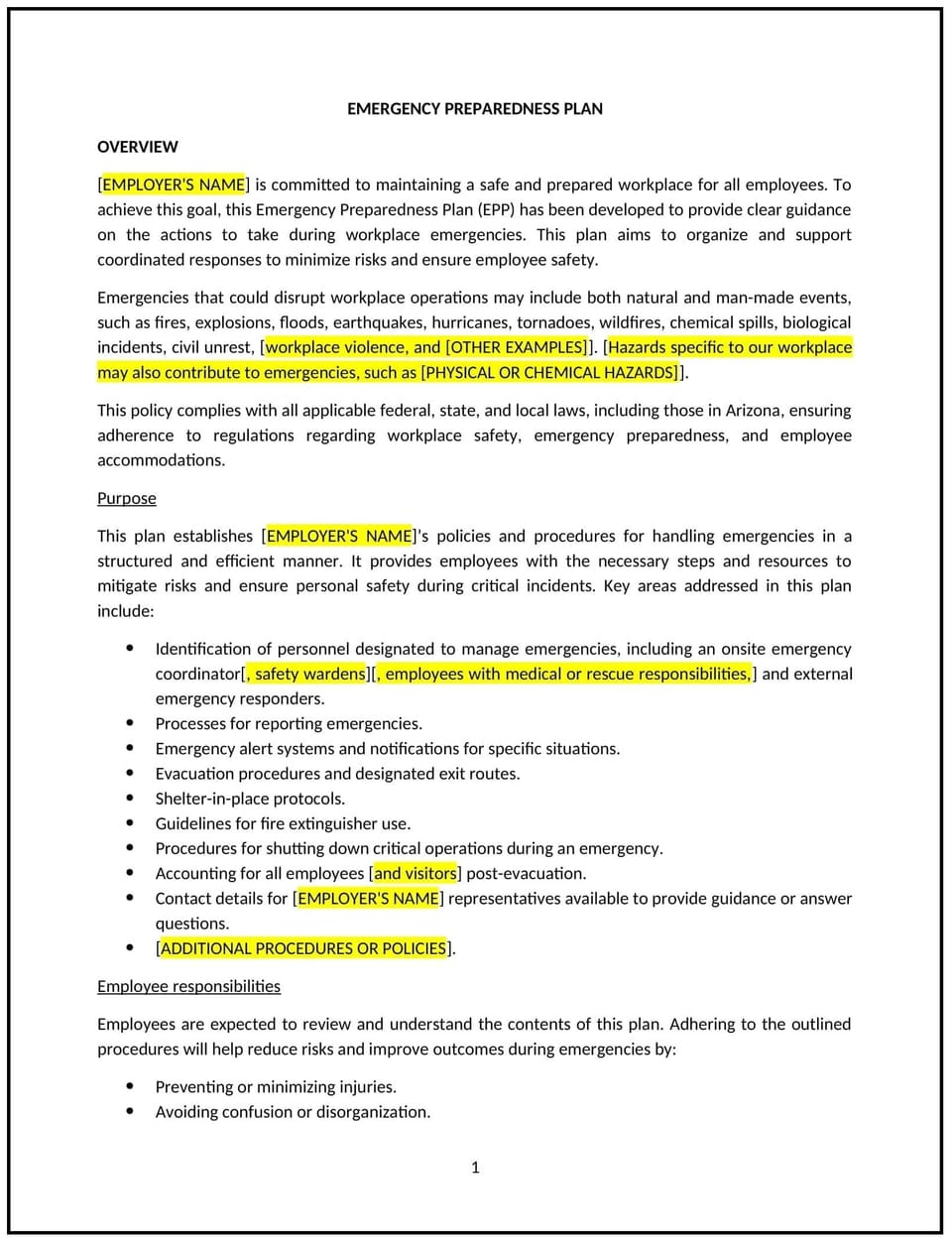Emergency preparedness plan (Arizona): Free template

Emergency preparedness plan (Arizona)
In Arizona, an emergency preparedness plan helps businesses establish procedures to protect employees, assets, and operations during emergencies such as natural disasters, power outages, or public health crises. This policy ensures organizations are equipped to respond effectively while minimizing risks and disruptions.
This plan outlines risk assessments, communication strategies, evacuation procedures, and recovery protocols tailored to Arizona’s unique challenges, such as extreme heat, wildfires, and monsoon storms. By implementing this plan, businesses can ensure safety, continuity, and compliance with state and federal regulations.
How to use this emergency preparedness plan (Arizona)
- Conduct a risk assessment: Identify potential emergencies relevant to your business location, such as flooding or wildfires, and assess their impact.
- Develop communication protocols: Establish methods for notifying employees, emergency responders, and stakeholders during a crisis.
- Plan evacuation routes: Create clear evacuation procedures and designate assembly points to ensure employee safety.
- Include response roles: Assign responsibilities to specific team members for tasks such as first aid, communication, and securing critical equipment.
- Prepare recovery steps: Outline procedures for resuming operations after an emergency, including damage assessment and restoring essential services.
Benefits of using an emergency preparedness plan (Arizona)
This plan offers several advantages for Arizona businesses:
- Enhances safety: Protects employees, customers, and assets by providing clear procedures for handling emergencies.
- Supports compliance: Aligns with Arizona workplace safety regulations and federal standards, reducing legal risks.
- Minimizes downtime: Reduces operational disruptions by ensuring a faster and more organized recovery process.
- Builds resilience: Prepares the organization to handle unexpected challenges effectively and maintain business continuity.
- Protects reputation: Demonstrates a commitment to employee well-being and organizational responsibility during crises.
Tips for using an emergency preparedness plan (Arizona)
- Address Arizona-specific risks: Include protocols for extreme weather events like monsoon storms, wildfires, and heatwaves.
- Train employees: Conduct regular training and drills to ensure all employees understand their roles and responsibilities during emergencies.
- Collaborate with local authorities: Work with emergency services and community organizations to enhance preparedness and response efforts.
- Use technology: Leverage tools like emergency notification systems and cloud-based document storage for efficient communication and data access.
- Review and update regularly: Periodically evaluate and revise the plan to address changes in risks, regulations, or business operations.
Q: What types of emergencies should this plan address?
A: The plan should address emergencies relevant to Arizona, such as wildfires, extreme heat, monsoon storms, power outages, and public health crises.
Q: How can businesses ensure employees are prepared?
A: Regular training sessions, drills, and clear communication of roles and procedures will help employees understand and follow the plan during an emergency.
Q: What are the key components of an effective evacuation plan?
A: Key components include clearly marked evacuation routes, designated assembly points, and communication protocols for accounting for all employees.
Q: How should businesses handle post-emergency recovery?
A: The plan should include steps for assessing damage, restoring essential services, and gradually resuming normal operations with employee and stakeholder updates.
Q: How does this plan support compliance with Arizona laws?
A: By aligning with state and federal workplace safety regulations, the plan helps businesses meet legal requirements and protect employees during emergencies.
This article contains general legal information and does not contain legal advice. Cobrief is not a law firm or a substitute for an attorney or law firm. The law is complex and changes often. For legal advice, please ask a lawyer.


